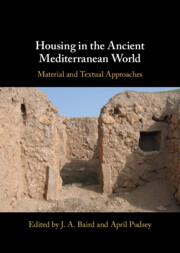Book contents
- Housing in the Ancient Mediterranean World
- Housing in the Ancient Mediterranean World
- Copyright page
- Contents
- Figures
- Tables
- Contributors
- Acknowledgements
- Introduction
- 1 Kinship ‘In the Halls’
- 2 Domesticating the Ancient House
- 3 Mind the Gap
- 4 A Family Affair
- 5 Textiles in Alkestis’ thalamos
- 6 Architectural Rhetoric and the Rhetoric of Architecture
- 7 The Reconstruction of an Agricultural Landscape
- 8 Mudbricks and Papyri from the Desert Sand
- 9 Housing and Community
- 10 The Elusive vestibulum
- 11 Living in the Liminal
- 12 Experiencing Sense, Place and Space in the Roman Villa
- 13 Houses and Time
- 14 Spaces of Desire
- 15 A Response: ‘Using the Material and Written Sources’ Revisited
- Index
- References
7 - The Reconstruction of an Agricultural Landscape
Seeking the Farmstead
Published online by Cambridge University Press: 08 July 2022
- Housing in the Ancient Mediterranean World
- Housing in the Ancient Mediterranean World
- Copyright page
- Contents
- Figures
- Tables
- Contributors
- Acknowledgements
- Introduction
- 1 Kinship ‘In the Halls’
- 2 Domesticating the Ancient House
- 3 Mind the Gap
- 4 A Family Affair
- 5 Textiles in Alkestis’ thalamos
- 6 Architectural Rhetoric and the Rhetoric of Architecture
- 7 The Reconstruction of an Agricultural Landscape
- 8 Mudbricks and Papyri from the Desert Sand
- 9 Housing and Community
- 10 The Elusive vestibulum
- 11 Living in the Liminal
- 12 Experiencing Sense, Place and Space in the Roman Villa
- 13 Houses and Time
- 14 Spaces of Desire
- 15 A Response: ‘Using the Material and Written Sources’ Revisited
- Index
- References
Summary
Farmsteads are ubiquitous across the Greek world. Within the canon of farmsteads, there are a variety of site types, which have a direct correlation to the socio-economic objectives of the household that used them. As a result, they are often the focus of scholarship for both archaeologists and historians who utilize the intersection between texts and archaeology to reconstruct a farmstead’s role within ancient agriculture. Frequently, a point of discussion is the relationship between the depiction of farming in textual sources, and the identification and interpretation of such sites, especially from the evidence of pedestrian landscape survey. This chapter describes a methodology for farmstead identification and a role-based classification. A holistic method is utilized that employs textual and archaeological data,with the aim of creating a well-rounded picture of how farmsteads functioned within an agricultural landscape. Following on from this, computational modelling is used to model the connectivity between sites and illustrate how different farmstead types could be used to complete farming tasks. The results from this chapter will demonstrate the value of employing a variety of evidence types to create models of the agricultural landscape that, in turn, further illuminate the experience of the ancient farmer.
- Type
- Chapter
- Information
- Housing in the Ancient Mediterranean WorldMaterial and Textual Approaches, pp. 229 - 260Publisher: Cambridge University PressPrint publication year: 2022



